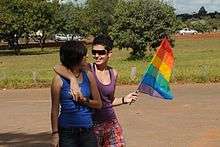LGBT people in Brazil

LGBT people in Brazil represent 8.35% of the Brazilians, or approximately 20,000,000 LGBT citizens.[1]
A 2009 survey[2] conducted by University of São Paulo revealed 7.8% of Brazilian males identified as gay and 2.6% identified as bisexual, for a total of 10.4% of the male population. Lesbians comprised 4.9% of the population and bisexual women comprised 1.4%, for a total of 6.3% of the female population.
The city of Rio de Janeiro has the highest percentage of non-heterosexual males, with 19.3% of it population being gay or bisexual men. The largest percentage of LGBT female population is located in the city of Manaus, 10.2% of whose women identify as lesbian or bisexual. The city of São Paulo, the largest Brazilian city, has the largest LGBT population.[2]
The sex composition of the LGBT population is distributed as follows: 64% male and 36% female. The composition of declared sexual orientation of the study population is distributed as follows: 54% said were gay, 28% said were lesbian, 17% said were bisexual, 1% did not fit in any of the above. The education of the LGBT population is distributed as follows: 57% have higher degree (university or college) complete, 40% have high school (school) complete. The composition of housing condition of the LGBT population is distributed as follows: 52% live with parents or relatives, 22% live with partners, 20% live alone, 6% live with friends.[3]
In 2010 a survey conducted by Ministry of Health of Brazil, revealed that the Brazilian gay population has more money than heterosexual population. The homosexuals were: A and B classes, 26.9%, C class, 49.9%, D and E classes, 23.2%. The heterosexuals were: A and B classes, 18.2%, C class, 47.8%, D and E classes 34%.[4]
In 2007 a survey conducted by Insearch, revealed that gays of Brazil spend 40% more with items related to leisure than heterosexuals. 84% traveled to Brazil four times over the past 12 months and 36% went abroad in the last three years. The Brazilian gays also read more, 88% read newspapers, and 94% read magazines. 73% have a habit of go to the movies three times a month on average, 46% go to the theater once a month and 57% buy eight books a year. Surpassing the national average.[5]
Approximately 80% of Brazilian LGBTs are residing in large cities, 50% came from interior.[6] The large cities of Brazil, known as gay-friendly, often contain a number of gay-oriented establishments, such as gay bars and pubs, gay nightclubs, gay bathhouses, gay restaurants. The most famous gay village of São Paulo is the Frei Caneca Street, and in Rio is the Farme de Amoedo Street.[7]
By proportion
Selected cities to the research:
| Rank | City | Percentage of City Population |
GLB
Population | |
|---|---|---|---|---|
| rank | ||||
| 1 | Rio de Janeiro | 14.30% | 1 | |
| 2 | Fortaleza | 9.35% | 2 | |
| 3 | Manaus | 8.35% | 3 | |
| 4 | São Paulo | 8.20% | 4 | |
| 5 | Salvador | 8.05% | 5 | |
| 6 | Brasília | 7.95% | 6 | |
| 7 | Belo Horizonte | 6.85% | 7 | |
| 8 | Curitiba | 6.55% | 8 | |
| 9 | Porto Alegre | 5.95% | 9 | |
| 10 | Cuiabá | 5.65% | 10 | |
By couples

Same-sex relationships in the same home by Brazilian regions, according to the 2010 IBGE Census:[8]
| Rank | Region | Same-sex Couples |
Same-sex
Couples | |
|---|---|---|---|---|
| rank | ||||
| 1 | Southeast | 32,202 | 1 | |
| 2 | Northeast | 12,196 | 2 | |
| 3 | South | 8,000 | 3 | |
| 4 | Central-West | 4,141 | 4 | |
| 5 | North | 3,429 | 5 | |
By GDP per capita
Same-sex couples had more GDP per capita (annual) than Opposite-sex couples, according to the 2010 IBGE Census:[9]
| GDP per capita (annual) | Opposite-sex Couples | Same-sex Couples |
|---|---|---|
| < R$3,270 (miserable) | 9.2% | 3.4% |
| R$3,270 < R$6,540 (poor) | 18.72% | 15.6% |
| R$6,540 < R$13,080 (relatively poor) | 10.56% | 25.14% |
| R$13,080 < R$32,700 (lower middle class) | 10.56% | 20.5% |
| R$32,700 < R$65,400 (middle class) | 3.41% | 9.55% |
| R$65,400 < R$130,800 (upper middle class) | 1.05% | 3.77% |
| > R$130,800 (rich) | 0.34% | 1.4% |
Technology
Homosexuals and heterosexuals by technology access:[10]
| Goods/services | Homosexuals | Heterosexuals |
|---|---|---|
| Smartphone | 47% | 40% |
| Laptop | 69% | 64% |
| Webcams | 76% | 72% |
| Tablets | 15% | 12% |
| LCD TV | 52% | 49% |
| GPS | 32% | 29% |
See also
- LGBT rights in the Americas
- LGBT rights in Brazil
- LGBT people
- Gay village
- São Paulo Gay Pride Parade
References
- ↑ 20 millions of Brazilians - LGBT people (Portuguese)
- 1 2 Percentages of LGBT Brazil (Portuguese)
- ↑ LGBT Census - Brazil (Portuguese)
- ↑ Brazilian homosexuals have more money than heterosexuals (Portuguese)
- ↑ Gays at the top of the pyramid (Portuguese)
- ↑ LGBT people and the cities (Portuguese)
- ↑ LGBT areas in Brazil (Portuguese)
- ↑ 60,000 same-sex relationships in Brazil - 2010 IBGE Census (Portuguese)
- ↑ Same-sex relationshipscouples in Brazil - 2010 IBGE Census (Portuguese)
- ↑ Technology in Brazil by sexual orientation (Portuguese)

.svg.png)